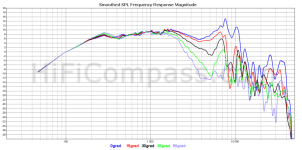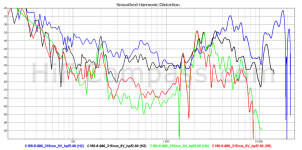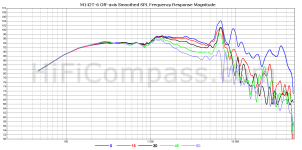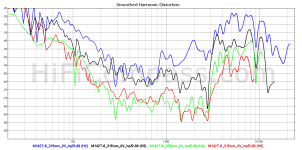Thank you @HiFiCompass. We all still hope you and friends and family are well. Incredible you can publish these great reviews.
#BliesmaSoEyewatering! 😎
Do you know if Stanislav ever tested/thought about carbon fibre for more products on the "lower" price range?
#BliesmaSoEyewatering! 😎
Do you know if Stanislav ever tested/thought about carbon fibre for more products on the "lower" price range?
Thank you, we are still holding on.
Regarding the low price TeXtreme products, I don't know really but think it is unlikely
Regarding the low price TeXtreme products, I don't know really but think it is unlikely
The measurements of the Scan-Speak 12M/4631G00 3" midrange have been updated:
https://hificompass.com/en/speakers/measurements/scan-speak/scanspeak-12m/4631g00
https://hificompass.com/en/speakers/measurements/scan-speak/scanspeak-12m/4631g00
Compare with Accuton C168 https://hificompass.com/en/speakers/measurements/accuton/accuton-c168-6-990-cell
Price for Accuton is 1500€ (inverted dome)
Price for Bliesma is 1000€ (dome)
Bliesma has less diameter, thus less directivity above 2kHz. Bliesma has much better distortion (measured with 8V)




Price for Accuton is 1500€ (inverted dome)
Price for Bliesma is 1000€ (dome)
Bliesma has less diameter, thus less directivity above 2kHz. Bliesma has much better distortion (measured with 8V)




Sensitivity! The Bliesma gives the same SPL already at 5,6V.Bliesma has less diameter, thus less directivity above 2kHz. Bliesma has much better distortion (measured with 8V)
It's the world of super high performance drivers, these are all crazy expensive. But Bliesma and Purifi at least perform ...
Yeah Accuton have always had the price but rarely the performance.
With back chamber sensitivity is even higher, so the difference would be bigger.Sensitivity! The Bliesma gives the same SPL already at 5,6V.
Note the increased gain will drop the distortion peak around 1 kHz by about 3 dB because the fundamental output will be increased in relation to the H2. The distortion peak at 2 kHz is H2 as well, but I'd be mightily interested in finding out whether a series notch filter at 6.3 kHz might knock that down a bit, as per this Purifi app note. Adding another series notch at 9.3 kHz could clean up the entire region between 3 kHz and 6 kHz when combined with the first notch.
These curves are from HifiCompass measurements showing 8 volts drive producing 106 dB, which should be adequate in most rooms.
These curves are from HifiCompass measurements showing 8 volts drive producing 106 dB, which should be adequate in most rooms.
Last edited:
Sensitivity! The Bliesma gives the same SPL already at 5,6V.
It's the world of super high performance drivers, these are all crazy expensive. But Bliesma and Purifi at least perform ...
One question remains : for non pro use, i.e. home living rooms, where the average SPL is 75 to 85 dB and transcients limited to what, 6 to 10 dB on CD libraries, can we do as good with less expensive drivers ?
No. But probably good enough. 🤓One question remains : for non pro use, i.e. home living rooms, where the average SPL is 75 to 85 dB and transcients limited to what, 6 to 10 dB on CD libraries, can we do as good with less expensive drivers ?
You would need to dive deeper in audibility of distortions (linear and nonlinear) and noise level of the room and masking.
Do we need a speaker with <0,1% THD?
My take - I simply try to build as good as possible and avoid as many mistakes as possible.
But you listen at pro level !
".... and nonlinear" : yup , it makes sense since Linkwitz papers (RIP)!
I also look a lot of H5 measurement from Hificompass .... and level voltage related to sensivity of the driver tested !
It is important to me because the DACS I use are veeeeeeeery transparent and tonaly tweaked to death whatever I listen few 192 K hz material ! I chose a transparent with no character amp because of that 'I'm sensible about tonality more than soundstage or ultimate details... although !) : Chord !
".... and nonlinear" : yup , it makes sense since Linkwitz papers (RIP)!
I also look a lot of H5 measurement from Hificompass .... and level voltage related to sensivity of the driver tested !
It is important to me because the DACS I use are veeeeeeeery transparent and tonaly tweaked to death whatever I listen few 192 K hz material ! I chose a transparent with no character amp because of that 'I'm sensible about tonality more than soundstage or ultimate details... although !) : Chord !
Here axial response with and without backchamber. But how was distortion measured?Question is, why was this measurement taken without recommended back chamber for Bliesma? Or maybe I see something wrong?
My take is that since off-axis is without a chamber, so are probably distortions. But we cannot know for sure. Maybe @HiFiCompass can comment on that? Anyway it looks very good because distortion plot lacks higher order harmonics in usable range and this peaks @1kHz and 2kHz are also second harmonics. Makes you also wonder how would distortions look like with let say low pass 24dB@3kHz.
ome said that this hige diameter voice coil were so-so at the end, as well.... (à la Audio Tekhnology drivers)
The distortion were measured without a back chamber. If that speaker was made with a back chamber I would measure it as is - with the back chamber. All the measured speakers should be in equal conditions so that their measurements could be comparable. The on-axis response at 2v83 is published just for illustrative purpose and not to give the impression that the speaker has an advantage over other speakers.My take is that since off-axis is without a chamber, so are probably distortions. But we cannot know for sure. Maybe @HiFiCompass can comment on that? Anyway it looks very good because distortion plot lacks higher order harmonics in usable range and this peaks @1kHz and 2kHz are also second harmonics. Makes you also wonder how would distortions look like with let say low pass 24dB@3kHz.
Last edited:
It was not the meaning to give it an advantage. In a sense, now it is understood that it's the by design that it should be used with this chamber, so it would be like any other mid-dome that has it's chamber already attached. At least it is my understanding of situation 🙂 , although i realize that it can also be used bare. Thanks for keeping up your work despite circumstances 👍The distortion were measured without a back chamber. If that speaker was made with a back chamber I would measure it as is - with the back chamber. All the measured speakers should be in equal conditions so that their measurements could be comparable. The on-axis response at 2v83 is published just for illustrative purpose and not to give that speaker an advantage over other speakers.
That's very important for sure!All the measured speakers should be in equal conditions so that their measurements could be comparable.
But it would be very helpful to have one of them measured with back chamber (maybe make a new chassis "M14sx with backchamber") to have an idea how it will perform in a real speaker and a real implementation. Cause nobody will use it without back chamber, so these measurements only have theoretical value.
Everything depends on your task. When producing 1000 speakers the task would be "best performance for the buck" or "best performance for budget XY".But you listen at pro level !
When only building 2 speakers for a listening room and spending month and years to optimise and perfect it - the price of the chassis is not the main point. Just do it right and then use it for the next 10-20 years.
There are not many tweeters out there which can deliver ANYTHING over 40kHz and even less who deliver something useful up there.whatever I listen few 192 K hz material !
I worked on a measurement speaker which can be used up to 100kHz ... while it's a nice feeling to use 192kHz material, speakers and headphones are not able to reproduce it.
- Home
- Loudspeakers
- Multi-Way
- Some speaker driver measurements...